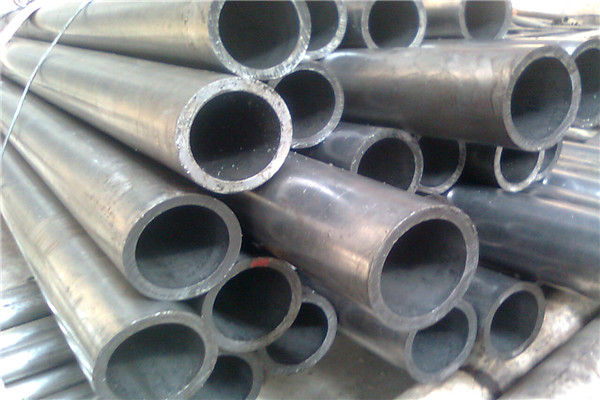Steel pipe is not only used for transporting fluids and powdered solids, exchanging thermal energy, making mechanical parts and containers, it is also an economic steel. Steel pipe is used to make the construction of structural grids, pillars and mechanical supports, to reduce the weight, saving metal 20 ~ 40%, and can realize the factory mechanized construction. Steel pipe for highway bridges can not only save steel, simplify construction, and can reduce the area of the protective coating, saving investment and maintenance costs. Large diameter steel pipe has a hollow cross-section, the length of which is much larger than the diameter or circumference of the steel. According to the cross-sectional shape is divided into round, square, rectangular and shaped steel pipe; according to the material is divided into carbon structural steel pipe, low-alloy structural steel pipe, alloy steel pipe and composite steel pipe; according to the use is divided into transport pipeline, engineering structure, thermal equipment, petrochemical industry, mechanical production, geological drilling, high-pressure equipment with steel pipe; according to the production process is divided into seamless steel pipe and welded steel pipe, which seamless steel pipe and Divided into hot-rolled and cold-rolled (drawn) two, welded steel pipe is divided into straight seam welded steel pipe and spiral welded steel pipe.
A large diameter steel pipe heat treatment process is how?
(1) in the heat treatment process, caused by large-diameter steel pipe geometry change is due to heat treatment stress. Heat treatment stress is a more complex issue, it is the cause of defects such as deformation and cracking, but also to improve the fatigue strength of the workpiece and an important means of service life.
(2) Therefore, it is important to understand the mechanism of heat treatment stress generation and the law of change, and to master the method of controlling internal stress. Heat treatment stress is the stress generated inside the workpiece due to heat treatment factors (thermal process and tissue transformation process).
(3) It is self-balancing within the whole or part of the volume of the workpiece, so it is called internal stress. Heat treatment stress is divided into tensile and compressive stresses according to the nature of its action; it can be divided into instantaneous and residual stresses according to the time of its action y and into thermal and tissue stresses according to the cause of its formation.
(4) Thermal stress is formed due to the non-simultaneity of temperature changes in various parts of the workpiece during the heating or cooling process. For example, for a solid workpiece, the surface is always hotter than the heart when heated, and the heart is slower than the surface when cooled, because the absorption and dissipation of heat are conducted through the surface.
(5) composition and organization of the state of large-diameter steel tubes do not change, at different temperatures, as long as the coefficient of linear expansion is not equal to zero, will cause changes in the specific volume, and therefore in the heating or cooling process, the workpiece between the heart of the table will produce mutual tension stress. Obviously, the greater the temperature difference within the workpiece, the greater the thermal stress.
Second, the quenching process of large diameter steel pipe after the cooling?
(1) quenching process workpiece to be heated to a higher temperature, take a faster rate of cooling, so in the quenching, especially in the quenching and cooling process, will produce a large thermal stress. Diameter of 26 mm steel ball, heated at 700 ° C after cooling in water, the temperature change of the surface and the heart.
(2) At the beginning of cooling, the cooling rate of the surface significantly exceeds that of the heart, and the temperature difference between the surface and the heart increases continuously. When cooling continued, the cooling rate of the surface slowed down, while the cooling rate of the heart increased relatively fast, and when the cooling rate of the surface and the heart were nearly equal, their temperature difference reached a large value.
(3) Subsequently, the cooling rate of the heart is greater than the cooling rate of the surface, and the temperature difference between the surface and the heart gradually decreases until the heart is cold through, the temperature difference also disappears. The process of generating thermal stress in the case of rapid cooling.

(4) At the beginning of cooling, the surface layer cools, and the temperature difference between it and the heart begins to arise. Due to the physical properties of thermal expansion and contraction, the volume of the surface layer has to shrink, while the temperature of the heart is still high and the specific volume is large, which will prevent the surface layer from contracting freely inward, thus forming the thermal stress of the surface layer under tension and the heart under compression.
(5) With the cooling process, the above temperature difference continues to increase, the resulting thermal stress also increases accordingly, when the temperature difference reaches a larger value, the thermal stress is also large. If the thermal stress at this time, lower than the yield strength of steel in the corresponding temperature conditions, will not cause plastic deformation, only a trace of elastic deformation.
(6) When further cooling, the surface cooling rate slows down, the heart of the cooling rate correspondingly accelerates, the temperature difference tends to reduce, the thermal stress is also gradually reduced. With the reduction of thermal stress, the above elastic deformation is also reduced accordingly.
